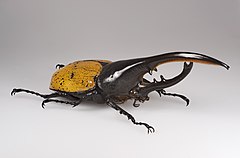Hercules beetle
This article needs additional citations for verification. (August 2012) |
| Hercules beetle | |
|---|---|

| |
| Male Hercules beetle, Dynastes hercules. | |
| Scientific classification | |
| Kingdom: | |
| Phylum: | |
| Class: | |
| Order: | |
| Family: | |
| Subfamily: | |
| Genus: | |
| Species: | D. hercules
|
| Binomial name | |
| Dynastes hercules | |
The Hercules beetle (Dynastes hercules) is the most famous and largest of the rhinoceros beetles. It is native to the rainforests of Central America, South America, and the Lesser Antilles. The beetle has also been observed as far north as Southern Arizona, in the county of Pima. Their title is well deserved, with some able to lift almost 850 times their own weight and some males, rarely, can reach 17 cm (6.75 inches) in length. It is the largest of the 6 species in the Dynastes genus, and one of the largest beetles known, being exceeded in length by only two other beetles in the family Cerambycidae, Macrodontia cervicornis (specimens of 17–17.5 cm are known) and Titanus giganteus (also up to 17–17.5 cm; several 18+ cm specimens are reputed/alleged to exist). However, if the horns are excluded, both Macrodontia Cervicornis and Dynastes Hercules drop considerably farther down in the size rankings, leaving the titan beetle on top. One reason for this is that the development of the horns is allometric, as well as sexually dimorphic, and thus not strictly correlated to actual body size; it is possible for a female to be much longer, measured from eyes to abdomen, than a male, yet be considered "smaller" simply due to the absence of horns.


As noted above, Hercules beetles are highly sexually dimorphic, with the females generally being larger-bodied but much shorter, as they lack horns entirely. The larval stage of the Hercules beetle will last one to two years, with the larva growing up to 4.5 inches (11 cm) in length and weighing up to 120 grams (0.26 lbs). Much of the life of the larva is spent tunneling through its primary food source of rotting wood. After the larval period, transformation into a pupa, and molting, the beetle then emerges as an adult. Adults will roam the forest floor in search of decaying fruit.
Subspecies
- Dynastes hercules baudrii Pinchon, 1976
- Origin: Martinique
- Male size: 50–100 mm; female: 45–55 mm
- Dynastes hercules bleuzeni Silvestre and Dechambre, 1995
- Origin: Venezuela
- Male size: 55–155 mm; female: 45–75 mm
- Dynastes hercules ecuatorianus Ohaus, 1913
- Origin: Colombia, Peru, Ecuador, Brazil
- Male size: 55–165 mm; female: 50–80 mm

- Dynastes hercules hercules Linnaeus, 1753.
- Origin: Guadeloupe, Dominica
- Male size: 45–178 (max: 220 mm?); female: 50–80 mm

- Dynastes hercules septentrionalis
- Origin: Extreme Southern Mexico, Central America
- Male size: 50–150 mm; female: 40–80 mm
- Dynastes hercules tuxtlaensis Moron, 1993
- Origin: Mexico
- Male size: 70–110 mm; female: 45–60 mm
See also
- Allometry
- Coleoptera in the 10th edition of Systema Naturae
- Dru Drury
- Guadeloupe National Park
- List of largest insects
- Palisot de Beauvois
- Wildlife of Costa Rica
References
Further reading
- Catálogo electrónico de los organismos presentes en Colombia Template:Es icon
- Mystery behind the strongest creature in the world Institute of Physics 2008-03-11
- Gilbert Lachaume: The Beetles of the World, volume 5, Dynastini 1, 1985, Sciences Nat, Venette. [1]
External links
- - Arkansas Hercules Video
- Family Scarabaeidae - Dynastes hercules
- The Breeding/Rearing of Dynastes hercules hercules
- Photos of Dynastes hercules ecuatorianus
- Photos of Dynastes hercules hercules
- Photos of Dynastes hercules lichyi
- Photos of Dynastes hercules occidentalis
- Clemson University Arthropod Collection
- Rhinoceros beetle gallery with many subspecies of Hercules beetle.
- [2] A sub-adult specimen from Chiapas, Mexico.
